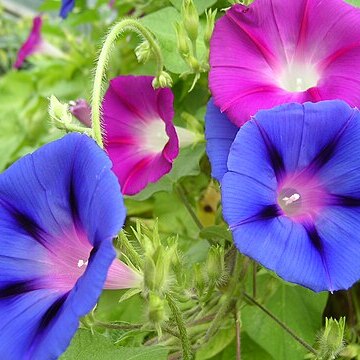Herbs or shrubs, usually with twining or climbing stems or erect, often with milky juice. Leaves alternate, simple, entire, dissected, or compound, absent in parasitic species. Flowers solitary, axillary or in cymes, racemes, panicles, umbels, or capitula, bisexual, actinomorphic, usually 5-merous, often showy. Sepals free, often persistent, sometimes enlarged in fruit. Corolla sympetalous, funnelform, campanulate, salverform, or urceolate; limb subentire or deeply lobed. Stamens alternating with corolla lobes, adnate to corolla; filaments filiform, equal or unequal in length; anthers introrse, laterally and longitudinally dehiscing; pollen smooth or finely spiny. Disc ringlike or cupular. Ovary superior, mostly 2-carpellate, 1-or 2-loculed, rarely 3-or 4-loculed; ovules basal, erect. Styles 1 or 2, terminal (gynobasic in Dichondra) or very short or absent; stigma entire or 2-(or 3)-lobed, rarely peltate. Fruit a capsule, dehiscing by valves, circumscissile, or irregularly shattering, less often a berry or nutlike. Seeds usually trigonous, smooth or pubescent.
Herbs, shrubs or leafless parasites, rarely small trees, frequently twining or prostrate, less often erect. Leaves alternate, exstipulate, usually simple, entire or often lobed. Flowers usually bracteate, axillary or terminal, solitary or in various inflorescences, almost always regular, hermaphrodite save in a very few small genera. Sepals 4–5, imbricate, free or joined at the base, often accrescent. Corolla sympetalous, variable but often funnel-shaped or salver-shaped, entire or 4–5-lobed, induplicate-valvate or contorted. Stamens (3–)4–5, inserted in the corolla-tube, alternating with the lobes; pollen smooth or spinulose. Ovary superior, entire or 2–4-lobed, of 2–3 carpels, 1–4 (very rarely 3 or 5)-locular. Styles 1–2(–3), simple and terminal; stigmas 1–4, variously shaped. Fruit usually dry and capsular, rarely a berry or nut-like. Seeds 1–4 (rarely 6 or 10), with endosperm
Ovary superior, entire or 2–4-lobed, of 2(3–5) carpels united, (1) 4 (3–5)-locular, usually with an annular nectary-disk around the base; styles 1–2 (3) mostly terminal; stigmas 1–4 variously shaped; ovules 2 per carpel (rarely many in Humbertia), basal or basal-axile, erect, anatropous
Flowers often large and showy, usually bracteate, axillary or terminal, solitary or in various inflorescences, almost always regular, bisexual save in a very few small genera, 5-merous as to the calyx, corolla and androecium (4-merous in Hildebrandtia)
Stamens as many as and alternate with lobes or connate members of the corolla, inserted in the corolla tube; filaments often unequal; anthers tetrasporangiate or dithecal, opening by longitudinal slits; pollen smooth or spinulose
Herbs or shrubs, rarely small trees, frequently twining or prostrate, less often erect, provided with diverse sorts of glandular and eglandular hairs, besides simple, 2-armed or stellate hairs
Seeds 1–4 (rarely 6 or 10) with endosperm; embryo large, straight or curved, with 2 plicate, often bifid cotyledons, embedded in a hard, often cartilaginous endosperm
Fruit usually dry, a loculicidal (or sometimes irregularly dehiscent) capsule, or less often indehiscent and baccate or nut-like
Corolla sympetalous, variable but often funnel-shaped or salver-shaped, entire or 4–5-lobed, induplicate-valvate or contorted
Stamens 5, inserted towards the base of the corolla-tube and alternate with the lobes; anthers 2-celled, opening lengthwise
Ovary often surrounded by a disk, 1-4-celled; ovules solitary or paired, erect; style terminal
Sepals imbricate, sometimes unequal, generally free or connate at the base, often accrescent
Seeds sometimes hairy, with rather scanty endosperm and more or less curved embryo
Leaves alternate, exstipulate, usually simple, entire or toothed to often lobed
Flowers hermaphrodite, actinomorphic; bracts often forming an involucre
Herbaceous or woody plants, often climbing, juice usually milky
Corolla gamopetalous, mostly funnel-shaped, lobes 5, contorted
Sepals usually free, imbricate, persistent
Leaves alternate, simple; stipules absent
Cotyledons folded or crumpled
Fruit a capsule or fleshy



